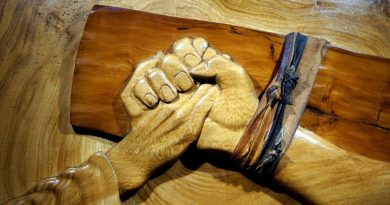How Did We Get the Bible?
By S. Douglas Woodward
The Bible has been transmitted through various means.
The Septuagint and Masoretic Text are based on slightly different Hebrew originals, with most scholars arguing the LXX’s “Vorlage” is older than the MT’s.
One of the most noteworthy elements differing between these textual traditions is the chronology’s presented in Genesis 5 and 11. But didn’t the MT protect the text from changes? Isn’t the MT version the one that Young Earth Creationists rely upon? What are the ancient codices and why are they important to assure us that we have authentic copies of the originals, the “autographs”?
Higher textual criticism, often seen correctly as a plague upon biblical truth, doesn’t offer us as Christians with a high view of biblical inspiration much value.
However, “lower” textual criticism constitutes a much different story. It helps us know what words the original text most likely contained. It has greatly helped overcome challenges in the text during the past 200 years or so, due to its meticulous examination of hundreds (if not thousands) of manuscript fragments newly discovered during those past 200 years – fragments that are very old (aka “early”) for both the LXX and the MT.
This certainly includes the Dead Sea Scrolls, but many other discoveries have also impacted the process we call textual transmission. To appreciate this, we must understand the progression leading up to the codices of the Old Testament, what these codices are, where they were discovered and obtained, and how they served as the basis for modern versions of the Bible we revere today.
First off, we know that scribes continued to copy the texts of the Hebrew Bible from the second century to the end of the fifth century. It is highly likely that all the adjustments to the Bible that the rabbis felt must be made, had been made before the end of the second century. Polemically speaking, “the damage had been done.” Thenceforth, for the Jews, accuracy in the MT became paramount.
Around the fifth to sixth century A.D., a group of scribes came into being called the Masoretes (from which the Masoretic Text gets its name). Dr. Paul D. Wegner, Professor of Old Testament Studies and Director of the Advanced Studies Programs at Gateway Seminary, in Ontario, Calif., states that the Masoretes inherited the scribal traditions of their predecessors but increased the rigor around their copying process by using a series of counts to ensure that no letters were added or lost.
But when we hear of how meticulous these scribes were, we need to remember that they were excruciatingly careful to prevent accidental changes in the text after the changes made at Jamnia were already in place. We also need to make special note that while Jewish scribes even before the birth of Christ took great care with some sort of systems to assure scribal errors would be few and far between, these most meticulous practices of the Masoretes did not come into play until the time of the Masoretes. Wegner gives us the details:
“There were two major venues of Jewish scholarship, one in Babylon and one in Palestine. Following the Islamic conquest of Palestine in A.D. 638, Tiberias once again revived and became the chief center for Jewish textual studies. From about A.D. 500 to 800 the Masoretes added vowel points, accents, and the Masorahs [Masorahs equal metadata] (to help safeguard the text from error), as well as many scribal corrections.”
Masorete Scribes

Wegner explains that there were two families responsible for copying – the Ben Asher and Ben Naphtali families. Although once considered rivals with differing textual traditions, only eight minor consonantal differences materialized through the years, although “vowel pointing” (vocalization hints) varied.
Going all the way back to the Dead Sea Scrolls’ (DSS) manuscript fragments, it can be verified that ancient scribes made notations (little diamonds) above letters or words in doubt, to call attention to possible scribal errors in the text. The Masoretes did this too. Eventually, as to these two separate methodologies, the Ben Asher tradition became the de facto winner while the Ben Naphtali tradition faded away. The Aleppo Codex (ninth century) and Codex Leningradis (tenth century) were Ben Asher texts.
Collections of the various books in the Hebrew Bible were assembled in a codex instead of a scroll. This wasn’t new. This practice had been commonplace for over a thousand years. The codex, you may recall, involves “stitching together” leaves or pages to assemble a book instead of a scroll. Nevertheless, the first complete codex of the Hebrew Bible would not be discovered until the eleventh century A.D., half a millennium after the Masoretes began their work; 900 years after Akiba altered the text; and over 1,100-1,300 years from the Hebrew copies of the manuscripts used in constructing this proto-Masoretic Text.

Verse numbering had initially taken place with the Latin Vulgate, ca. 1200 A.D. This numbering process found its way into the Hebrew for the first time about 130 years later (1330). Now, as to the printed Hebrew Bible (post-Gutenberg that is), a complete Bible (Old Testament) was published in 1488 while the first Rabbinic Bible was printed in 1517 with commentary.
As stated earlier, the first complete pseudo-ancient Hebrew Bible in existence today (extant) is the Leningrad Codex (Codex Leningradensis) dating to about 1008 A.D. It is, as the name indicates, kept in Leningrad in its Public Library. Wegner states:
“The Dead Sea Scrolls provided texts of the Old Testament approximately one thousand years earlier, and their impact was explosive on the field of textual criticism. Careful study of these manuscripts has helped to confirm that the Hebrew text we possess is very accurate; differences are minimal between a good number of the Dead Sea Scroll manuscripts and manuscripts from about A.D. 800 to 1000. However, even the Dead Sea Scrolls reveal a certain amount of diversity in the Old Testament in the centuries right before Christ. Some texts found near Qumran appear to follow more closely the Samaritan Pentateuch, others tend toward the Septuagint, and still others reflect the Masoretic Text.”
However, when we count the differences between the versions, the numbers aren’t that small. For instance, the Samaritan Pentateuch (SP) differs from the MT in 6,000 places. It also varies with the LXX, but in far fewer places – only about 1,600 instances. This has led to the view that the LXX and SP were both following one family of “archetypes” or textual traditions, and the proto-Masoretic another.
The Samaritan Pentateuch’s tradition begins at the time of Nehemiah’s dispute with Sanballat around 450 B.C. Those Samaritans who followed Sanballat’s lead, relocated their holy place away from Mount Zion in Jerusalem to Mount Gerizim in Samaria.
Changes would eventually be made in their textual tradition of the Pentateuch to support the Samaritan point of view instead of the Jewish one. This tradition would likely have followed the development of the Septuagint, making it from the third or second century, B.C. (The LXX was present in Samaria and Judea probably by 260-250 B.C.)
We know that the Hebrew Vorlage, from which the SP textual tradition began, made use of the same proto-Hebrew script (like the Aramaic cursive script which the ancient Hebrew Vorlage used.
Modern Hebrew “square characters” (with which we are familiar) were used well before the time of Jesus but became standard afterward, ca. 100 A.D. The square characters were characteristic of Babylonian, Aramaic, and later, Hebrew.
When we consider the alterations in the text pertinent to the implied chronology of Genesis 5 and 11 which occupy our attention later, the SP generally agrees with the LXX and not the MT. As noted above, the Vorlage for the SP and the LXX might have been the same. The MT Vorlage (many generations of copies) arises hundreds of years after the Hebrew Vorlage which was used when creating the SP and LXX. Logically (and evidentially), the MT was altered and not the other way around.
Why Are the Chronologies So Different Between the Three Traditions?

Many critics suggest that the LXX’s translators living in Alexandria (Egypt), altered the Genesis’ chronology to synchronize Hebrew history with the Egyptians, due to “historical envy” (as to whose history was the oldest – but most scholars don’t agree).
This argument is frequently put forth to justify why the MT has different genealogical records so that its dates are held out to be sacrosanct, protecting the KJV from “expressing erroneous information.”
Specifically, critics of the LXX contend, “there was no reason for the scribes copying the [Hebrew] MT to alter the intervals in Genesis 5 and 11; therefore, the MT must be right.” LXX naysayers make these anachronistic statements without considering the timing associated with each of these three versions – that is when their respective Pentateuch’s were initially created. Additionally, the investigative (text critical) analysis is tedious, despite bearing conclusive fruit.
To press the point further: Critics of the LXX are apparently unaware of the MT makeover we’ve covered in my new book Rebooting the Bible. We know the Genesis genealogies as they appear in the LXX and SP differ from the MT in several entries.
Specifically, almost all the ages of the Patriarchs when they died are the same in all versions, but what is different is the age when the Patriarchs “begat the next entry in the genealogy.” The son mentioned is often misunderstood to be the first-born son. But the son through whom the Messiah would one day come was not necessarily their first-born. Because this fact amounts to yet another controversy (this one between Bible believers and those who doubt the historical record of the Scripture), we must explore these details.
Indeed, we will show evidence from Archeology in Part 2 of Rebooting the Bible (to be published in late Summer 2019), that provides pieces of scientific data supporting the LXX’s timeline – enabling us to reconcile the timelines of the Bible and archeology – demonstrating that the genealogies recorded in Genesis 5 and 11 provide a sequential, unbroken lineage yielding a reliable chronology.
This corrected chronology (which is the inspired, original Genesis chronology) overturns the popular chronology associated with the “Bishop Ussher” timeline. Unfortunately, “KJV only” advocates and those contending for a “Young Earth” force the facts they present to fit Ussher’s math and research.
This is most unfortunate. The chronology of the KJV, which is identified with Bishop Ussher and the Young Earth theory, do not need to be linked. In other words, we could throw away the Bishop Ussher chronology and still argue for a Young Earth. And we could throw away the KJV chronology and still contend for an infallible Bible. In my view, these connections need to be broken. That is a major reason for writing Rebooting the Bible. The linkage between YEC and KJV harms our evangelism.
Let me emphasize this again to be clear: These factors do not have to be linked, but they are in every single presentation I have seen from those who contend for the “Young Earth.” The Septuagint timeline would benefit the Young Earth argument in many ways which, as I said, will be covered in Part 2. So, Young Earth presentations should stop using the KJV chronology, and begin using the LXX timeline, which adds (as we will document) over 1,500 years to the biblical timeline in Genesis 1 – 11.
The Transmission of the Greek Version of the Hebrew Bible

While the proto-MT codex (containing almost all biblical books) is dated to the year 1008, there are three Greek (i.e., Christian) codices that predate it by 600-700 years which are mostly intact. Once again, the number and dating of codices support the verdict that the LXX more closely resembles the autographs of both the Old Testament.
Additionally, we know that the LXX quotations from the OT cited by the NT, comprise between 80-90 percent of all OT references) – yet another factor strengthening the case for the LXX over the MT. It’s time we learn more about codices.
Indeed, the history of these codices is intriguing. Each has its own features. We will recap their respective stories.
The first and most esteemed codex is Codex Vaticanus, dated to the middle of the fourth century, about 100 years after Origen (184–253 A.D.) and contemporary with Athanasius (296–373) A.D. an Alexandrian who was the most noteworthy activist for orthodox Christology and the Trinity. As with all the codices, there are missing sections, although the percentage of missing portions is quite low. Codex Vaticanus is known as Codex “B,” and it has been stored at the Vatican library since 1475. Since the Vatican relied upon the Latin Vulgate as its official Bible, work on this codex was discouraged.
In fact, Codex B wasn’t published until 1867. According to Wegner, while the Vatican made a photographic facsimile of the Codex in 1889-90, it was still not widely circulated for study by scholars. (It’s likely there was suspicion that the Greek Bible could contradict the Latin Bible.)
Beginning with St. Augustine in the fifth century, there was considerable contention that the Latin Version should be translated form the Greek, rather than a Hebrew textual tradition. But Jerome elected to use the Hebrew and brought the Akiba alterations into his Vulgate, the Catholic Bible.
The second most highly regarded Codex is Codex Alexandrinus. This codex is known as Codex “A.” It is dated to the middle of the fourth century, within perhaps two decades of Jerome (347 – 420 A.D.) and Augustine (354 – 430 A.D.) It is the first great “uncial” (a majusculescript, i.e., basically “all caps”) codex that was made available to scholars. Its books are ordered slightly different from today’s LXX. It includes many of the “apocryphal books” plus two letters from an early Bishop, Clement of Rome (circa 95 A.D.) It contains scribal corrections, indicating it was subject to careful review during its earlier life. Wegner provides some interesting detail:

In 1627, Cyril Lucar, patriarch of Constantinople (1621 – 1638), offered this manuscript to the English ambassador to Turkey, Sir Thomas Roe, as a gift to King James I. However, it came to England after King James had died and was instead presented to Charles I of England. Lucar probably obtained Codex Alexandrinus while he was Patriarch of Alexandria (1602 – 1621), hence its name. The codex was housed first in the Royal Library, but in 1757 it was incorporated into the British Museum in London.
Note the interesting timing here. The codex, if it had come to England a decade or so earlier, would likely have influenced the King James Bible (the KJV is the King’s namesake), as the scholars working on the Bible would have had a full and worthy copy of the Septuagint before them – and not just a handful of texts following the MT.
No doubt, its age would have swayed the translators toward many of the wording choices in the LXX (which I cover in detail in Rebooting the Bible, Part One), which built a stronger case for the deity of Jesus Christ and the nature of His incarnation.
However, King James I died in 1625, and Charles I was no help in seeing the KJV revised in accordance to the LXX as he was too busy battling with Oliver Cromwell for political control of the nation (and whether the English should be Catholic or Protestant). And I should mention in passing, that he attempted – unsuccessfully – to escape hanging (he famously went to the gallows in 1649). We can only speculate that the final form of the King James Bible might have been significantly different had the Codex arrived 15 years earlier.
Nevertheless, these chance dates give one pause. This author suspects the implication for Jewish conversion might have been momentous. The English, unlike the Swiss and the Germans, were highly supportive of the Jews’ right to worship freely (Cromwell was the first “ruler” to endorse it). The English Puritans supported “Restorationism” in the seventeenth century, an early form of Dispensationalism (200 years before Darby). But the timing of a Jewish “revival” was not to be. England’s King James Bible was printed without reference to either the Vatican’s Codex B (locked in its library); or Codex A that “missed the bus” for consideration by KJV translators by a matter of 15 years or so.
Why Sinaiticus is Thought to be Cyanide

Finally, the earliest of the codices, the third of three, is the most recently discovered at the traditional location of Mount Sinai on the Sinai Peninsula, at St. Catherine’s Monastery. This codex is known as Codex Sinaiticus, aka “S,” and has also been dated to the middle of the fourth century.
Its unique contents include the Shepherd of Hermas and the Epistle of Barnabas which were all but lost before this find. Like all the codices, it was written on vellum (calf skin – the key to the survival of the codices). It contains far more mistakes of various kinds than the other codices. These include poor spelling and use of vulgar language! (In this instance, vulgar may be better understood as “everyday expression” rather than dirty words!) [11] Notwithstanding, its story is intriguing.
It seems that Constantin von Tishcendorf (1815-1874), a beginning lecturer at the University of Leipzig who had been instrumental in promoting Codex Vaticanus, was also the discoverer of Codex Sinaiticus. Tischendorf had been trolling the Middle East looking for ancient manuscripts and was studying in the library at St. Catherine’s in 1844 when he discovered a basket with old leaves of manuscripts thought to be destined for burning. He noted that they were ancient “book leaves” and asked only if he could have them instead of their being used as kindling for the monk’s fire. The monks agreed, and the hook was set. To his detriment, he displayed too much enthusiasm, so the monks became unwilling to part with their parchments.
Over the next two decades, he made two more trips to the monastery. Finally, on the third trip (yep, “third-time is always the charm”), he struck gold. When proudly showing the steward of the library his newly printed copy of the Septuagint, the steward related that he also had a copy of the LXX, but the steward’s copy wasn’t so new or well bound! The steward brought out a hulking pile of loose leaves wrapped in a red cloth. This time, Tischendorf hid his enthusiasm as he glanced through the material. With the stewards “leave,” he spent the night reviewing the stack of loose leaves. During his “all-nighter” he carefully inspected this diamond in the rough. Early in the morning, he might have yelled out “Eureka! I’ve found another codex!”
Before him lay most of the Greek Old Testament (the LXX) and a completed New Testament. And it was apparently ancient. He tried, unsuccessfully, to purchase the old LXX from the monks. He made several more attempts in the months ahead to buy what would become Codex Sinaiticus but to no avail. And yet, eventually, his persistence paid off. What money couldn’t buy, kindness relinquished to him, for he finally received “S” as a gift. Not too long afterward, in 1862, “S” was published, predating the far more restrained printing and distribution of the Codex Vaticanus by just a few years.
It turns out, this unexpected treasure was held in Russia until Lenin needed money; so, it was sold to the English for £100,000. Thus, in 1933, on Christmas Day, Codex Sinaiticus came to England! Ironically, Lenin, the atheist, strengthened the Christian faith by selling this valuable property for profit. Lenin, it seems, had reneged on Marxist principle, making money hawking property, and a Bible no less!
Daniel Wallace, perhaps the greatest New Testament textual scholar alive today, (who might be called the “Indy Jones” of ancient biblical manuscripts and serves as professor at Dallas Theological Seminary), recently presented an informative and vital update to the truths associated with Codex S and St. Catherine’s.
He defends the monks there by stating they really weren’t burning leaves, which was almost impossible to do (they were animal hides after all), not to mention they emitted an odious fragrance no one would have been capable of withstanding!
KJV-only advocates vehemently challenge Sinaiticus. They believe anything coming from Alexandria, Egypt (which is believed to be where this codex originated), is anathema (thus, overlooking Athanasius’ invaluable contributions). These three codices provide shorter versions of the New Testament books which often conflict with the Received Text (first set forth by Erasmus in 1516 and revised a dozen times before it was settled in 1633). Nevertheless, Wallace’s work has done a great deal to demonstrate “S’s” value to both Old and New Testament studies. He is on record stating that S is the most valuable of all codices, believing it to be the earliest of them all.
The Codices Controversy

There is considerable controversy surrounding the value of the various codices. The King James Onlyism crowd will dismiss the value of the Greek Bible’s first codices. However, among the principal academic theologians, there are no dissenting opinions: Scholars hold these codices in very high esteem. The KJV only group have little good to say about them. But that takes us into the debate between the Received Text and the early Alexandrian text. That is another story taken up in previous articles. And it’s a New Testament not Old Testament issue.


S. Douglas Woodward, Th.M., MA in Finance (to be completed, May 2019), is 64. He grew up in Oklahoma City, where he lives once again, after working in Boston for six years and Seattle for 21. Doug’s experience lies primarily in business information technology and financial management where he has served as an executive for Oracle, Microsoft, and a Partner at Ernst & Young LLP. He also founded his own consultancy for young companies, Smart Starters, which he managed for 10 years, before becoming Entrepreneur-in-Residence at the University of Oklahoma, Price School of Business, where he has taught classes in entrepreneurship for five years. Over the past seven years, Doug has become a nationally recognized author having written fourteen books on the topics of America’s spiritual history, eschatology, theology, and geopolitics. His books of note include The Final Babylon, Decoding Doomsday, Power Quest (Books One and Two), Lying Wonders of the Red Planet, The Revealing, The Next Great War in the Middle East, and Revising Reality. Rebooting the Bible is number fifteen. He frequently appears on radio and television programs having been interviewed on over 100 different occasions on several dozen different shows. Additionally, he speaks at conferences concerning the multiplicity of topics about which he writes. Doug has two amazing adult children, an incredible daughter-in-law, two fabulous grandsons, and a beautiful wife, Donna, with whom he celebrates over 43 years of marriage. Discover more at www.Facebook.com/sdouglaswoodward and www.faith-happens.com.



